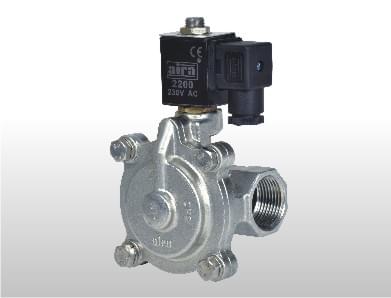What is a Solenoid Valve?
A solenoid valve 12v dc is an electromechanical valve that works utilizing an in-fabricated actuator as an electrical loop and an unclogger. An electrical sign controls the opening and shutting of the solenoid valve. There are two modes in which solenoid valves are delivered. They are regularly open and typically shut. The solenoid (electrical loop) is worked utilizing an AC or DC. DC supply is given through a battery, generator, or rectifier. While an AC supply is normally taken from AC mains voltage, through a transformer.
What is a Solenoid valve utilized for?
A solenoid valve is utilized to open, close, blend, or redirect fluid and vaporous media in an application. Solenoid valves track down wide applications in modern as well as homegrown areas. The utilization of solenoid valves goes from the control of standard cycle valves to the control of explicit valves like overpressure assurance frameworks and crisis stop valves, as well as liquid control in applications like fire framework valves. The significant benefit of a solenoid valve contrasted with conventional valves is the extremely quick reaction time. A portion of the normal applications include:
- Solenoid valves in refrigeration frameworks invert the refrigerant stream that cools during summer and warms during winter.
- Solenoid valves are utilized in blowers during the beginning stage to release the blower to diminish the force on the motor.
- Solenoid valves are utilized in water system frameworks for programmed control purposes.
- Solenoid valves in clothes washers and dishwashers control the water stream according to the prerequisite.
- Gaseous tension in cooling frameworks is constrained by solenoid valves.
- Programmed locking frameworks for entryway locks use solenoid valves.
- Vehicle washes and Industrial cleaning hardware use solenoid valves to control the water, cleanser, or synthetic stream.
- The inflow and surge of water in water tanks are regularly controlled utilizing solenoid valves.
- The strain, stream, and liquid bearing in constrained by solenoid valves in dental and different clinical gear.
Working of a Solenoid Valve
A solenoid valve has two fundamental parts: a solenoid and a valve body (G). The accompanying figure (Fig. 1) shows the regular parts of a solenoid valve. The electromagnetically inductive curl (A) around an iron center at the middle is known as the unclogger (E). Very still, it will be either typically open (NO) or ordinarily shut (NC). During the de-invigorated stage, an ordinarily open valve stays open while a regularly shut valve stays shut. At the point when current courses through the solenoid curl, it is empowered and makes an attractive field that makes an attractive fascination with the unclogger. Along these lines, the unclogger moves by defeating the spring (D) force. For a regularly shut solenoid valve, the unclogger is lifted and the seal (F) opens the hole permitting the media to course through the valve. While for typically open solenoid valve, the unclogger moves to descend and the seal (F) hinders the hole which prevents the media from coursing through the valve. The concealing ring as indicated by (C) in Fig. 1 forestalls vibration and murmuring in AC loops.

Types of Solenoid Valves
- Two-Way Solenoid Valves and
- Three-Way solenoid Valves
- Four-Way Solenoid Valves
Two-Way Solenoid Valves
As the name proposes, a two-way solenoid valve has one channel and one outlet funneling association. They can be sorted into the accompanying two sorts.
Normally closed construction: Valve is shut when de-energized and open when empowered.
Normally open construction: This kind of Solenoid valve is shut when stimulated and open when de-energized.
Three-way solenoid valves
Three-way solenoid valves have three line associations and two openings. Whenever one hole is open the other is shut as well as the other way around. Three-way solenoid valves are ordinarily utilized then again to apply strain to and exhaust tension from a stomach valve or single-acting chamber. They work in the accompanying three modes:
Regularly shut development: When the valve is de-stimulated, the strain port is shut and the exhaust port is associated with the chamber port. With the valve invigorated, the strain port is associated with the chamber pot and the exhaust port is shut.
Typically open development: The tension port is associated with the chamber port when the valve is de-invigorated. In any case, when the valve is empowered the tension port is shut and the chamber port is associated with the exhaust port.
All-inclusive development: This type permits the valve to be associated in either the ordinarily shut or typically vacant position. Moreover, the valve might be associated with selecting a couple of ports or redirecting the stream starting with one port then onto the next.
Four-Way Solenoid valves
Four-way solenoid valves are utilized to work twofold acting chambers. These kinds of solenoid valves have four or five-line associations; One strain, two-chamber, and a couple of debilitates. In one valve position, the tension is associated with the chamber port; the other is associated with the exhaust. In the other valve position, strain and exhaust are turned around at the chamber associations.
Contingent upon the elements of the solenoid valves, they are named
- Universally useful solenoid valves
- Wellbeing shut-off valves and
- Process-control valves
Universally useful solenoid valves: This kind of solenoid valve is either a typically open or ordinarily shut valve utilized for controlling the progression of a liquid. Nonetheless, these valves don't go about as security valves.
Security shut-off valve: This is regularly a shut valve of the "on" or "off" type that incites involving a wellbeing control gadget for forestalling hazardous liquid conveyance. A various port valve can fill in as a security shut-off valve concerning its regularly shut port.
Process-control valve: These sort of solenoid valves are endorsed to control combustible gases yet don't dependably fill in as a wellbeing shut-off valve.

